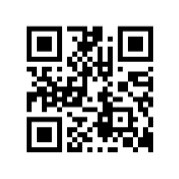Raising the Bar Code

Quick Response (QR) barcodes like this one were used during the recent Senior Showcase Exhibition.
For the first time ever, the Department of Interior Design & Fashion’s annual Senior Showcase Exhibition incorporated the use of Quick Response (QR) barcode technology, enabling visitors to learn even more about the exhibited pieces of student-designed garments and interior design plans in an immersive, interactive process.
Held in the Radford University Art Museum’s main gallery in the Covington Center for Visual and Performing Arts, the senior exhibition was part of the department’s two-week spring capstone celebration.
To help visitors use the emerging technology, signs were posted for guests entering the museum, providing simple step-by-step instructions for those with a cellular phone or mobile device capable of downloading barcode applications. Once the application was installed on their device, they could simply hold it up to the QR code on the wall next to each student’s submitted work, scan it and view a brief project overview via one-minute student video presentations.
“It’s a more three-dimensional experience,” said Holly Cline, interim chair of the department. “It allows the projects to have a face, where they can see the students and know they actually designed this.”
“This allows the student to provide a benefit to others, then the benefit comes back to them by being involved in the technology, being able to put it on their resume, and put it in their portfolios,” said Cline.
This year’s exhibition was “virtually juried” for the first time, allowing CVPA advisory board juror members who could not physically be in attendance to have the opportunity to review the projects and cast their votes from afar.
The exhibition’s innovative use of QR technology also has the potential to be utilized throughout the campus, according to Cline.
“There’s no reason why every exhibit over in the [RU Art Museum] gallery can’t have a QR code that would provide more information about the exhibits,” said Cline. “If you get a grant for say even 20 iTouches and headphones, then you’re right in business.”
Using QR technology further creates a more dynamic view of the design students, according to Cline, explaining how it allows potential employers to see how articulate and focused Radford’s design students are.
“We’re always trying to figure out what gives our students a leg up in the job market,” said Cline.